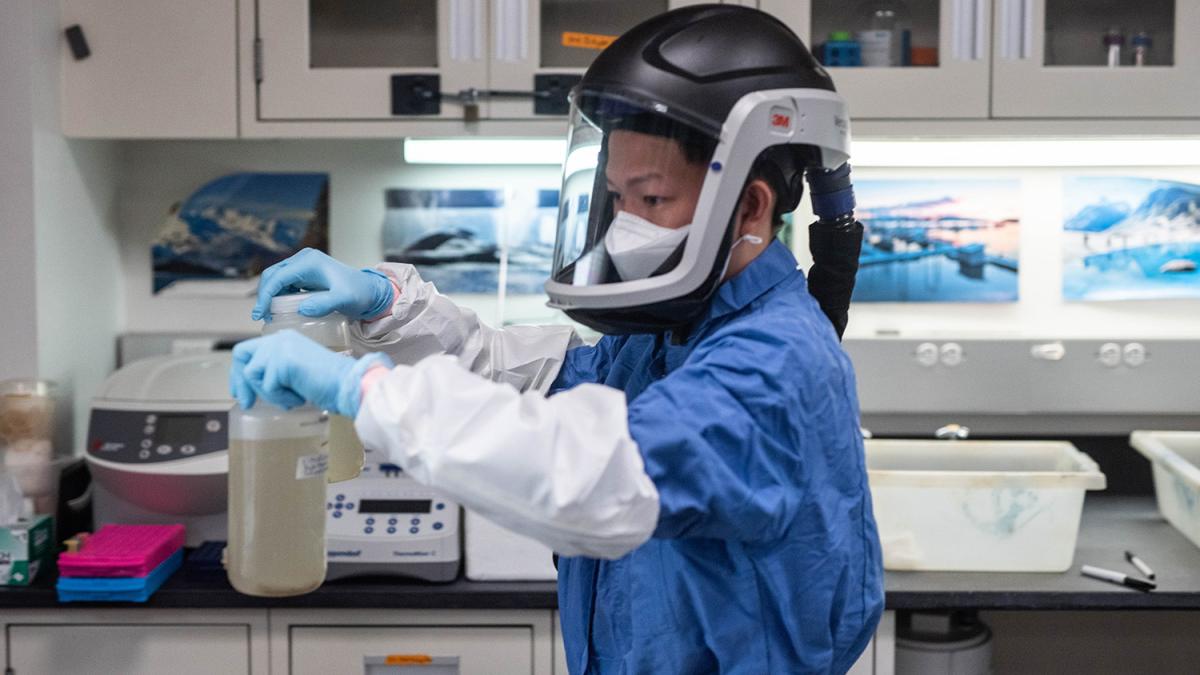
Angelo Ong, a research scientist in Meschke's lab, prepares wastewater samples for analysis. Photo: Veronica Brace.
DEOHS Professor Scott Meschke and coauthors recommend national wastewater surveying system to detect disease outbreaks in new National Academies report
Wastewater surveillance was a valuable component of the US public health response in the nation’s emergency response to the COVID-19 pandemic, and is worthy of further development and continued investment, says a new report from the National Academies of Sciences, Engineering and Medicine.

The report offers recommendations to strengthen nationwide coordination and ensure a national wastewater surveillance system that is flexible, equitable and sustainable to inform the public health response to COVID-19 and future infectious diseases.
The report also provides guidance for evaluating infectious disease threats for potential wastewater surveillance, said Scott Meschke, professor in the UW Department of Environmental & Occupational Health Sciences (DEOHS) and a coauthor of the report.
“We've laid out a framework for three criteria we think the CDC should consider: the public health significance of a threat, the analytical feasibility for wastewater surveillance and the usefulness of community-level wastewater surveillance data to actually inform public health decisions,” Meschke said.
Meschke’s lab has monitored SARS-CoV-2, the coronavirus that causes COVID-19, and other pathogens in wastewater in Washington state and beyond.
How wastewater disease surveillance works
Wastewater-based infectious disease surveillance systems detect the presence of biomarkers of infection, such as DNA or RNA, that are shed into a municipal sewer system. These surveillance systems can be used to identify changing levels of a pathogen or identify newly emergent variants in a community.
The National Wastewater Surveillance System (NWSS) was launched by the Centers for Disease Control and Prevention in 2020 in response to the COVID-19 pandemic.
Wastewater surveillance data proved to be useful during the pandemic to inform public health action, such as the allocation of public health and clinical resources, and will remain a critical data source in responding to the virus, says the report.
As at-home COVID-19 testing rose, individual reporting of cases decreased, emphasizing the importance of other tools such as wastewater surveillance for monitoring new variants and their spread.
Building public trust
“Looking forward, the success of a national wastewater surveillance program for infectious diseases relies on building public trust in the system, especially when ‘surveillance’ can be such a charged term in some communities,” said Guy Palmer, Regents Professor of Pathology and Infectious Diseases at Washington State University, and chair of the committee that wrote the report.
“Investment in this national system is important for strengthening public health, but sustaining that investment requires clearly communicating how wastewater surveillance benefits our communities while addressing privacy concerns.”
The report also offers recommendations for developing a more representative and equitable national system of community-level wastewater surveillance.
Vision for a national wastewater surveillance system
The report presents a vision for a national wastewater surveillance system that would be able to track multiple pathogens simultaneously and pivot quickly to detect emerging pathogens. The system must also be fiscally and operationally sustainable and monitor populations equitably.
When evaluating potential targets for future wastewater surveillance, the report says, CDC should establish a transparent process for prioritizing pathogens, and consider three criteria: the public health significance of the threat, the analytical feasibility for wastewater surveillance and the usefulness of community-level data to inform public health action.
In addition to expanding wastewater surveillance to currently underserved geographic areas, the NWSS sampling program, including the number and distribution of sampling sites and the frequency of sampling, should be subject to intentional design based on analysis of data for prioritized pathogens.
Specific “sentinel” sites should be incorporated, such as large international airports or zoos, to monitor for specific emerging pathogens at their points of entry.
The study, undertaken by the Committee on Community Wastewater-Based Infectious Disease Surveillance, was sponsored by the US Department of Health and Human Services.
Adapted from the full release here.
Contact:
Hannah Fuller, Media Relations Officer
National Academies of Sciences, Engineering and Medicine
Office of News and Public Information
202-334-2138; e-mail news@nas.edu


